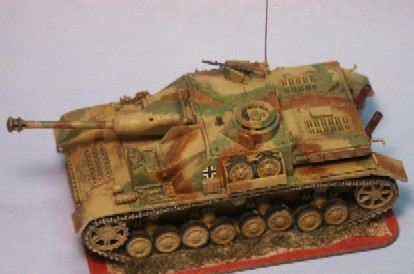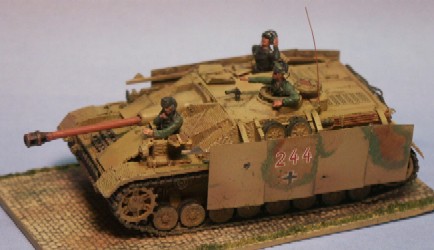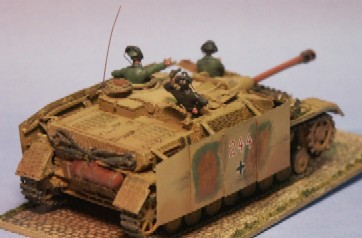SILK PURSE FROM A SOW’S EAR. A construction review and comparison in 1/72 scale. Revell/Monogram
[kit 3101] and the Dragon Models [kit 7260] Sd.Kfz. 167 Sturmgeschutz
IV. Dragon
Kit 7260 Revell
Kit 3101 To turn a “sow’s ear” into a silk purse denotes taking something very crude and rough and creating something fine and valuable from it. Those who are familiar with Revell’s Sturmgeschutz IV kit will know that it is very detail-challenged model of the StuG IV. Along with their M4A1(76) kit this is one of Revell’s initial 1/72-scale AFV kits, first marketed by Monogram under license. Compared to Dragon’s recent releases of the StuG IV early and late and Revell’s more recent excellent kits, Revell’s StuG IV leave much to be desired. Compare & contrast is a great way to learn about something so what better fun than to build both Revell & Dragon kits at the same time. The Revell kit would get all the bells & whistles detailing while the Dragon model would be built out of the box. The below review comments are my own and I am unassociated with any manufacturer or distributor. A Concise
Vehicle History For The Modeler 1. Revell’s StuG IV instructions are also clear and easily understandable; in the standard line drawing method long the norm. The Revell kit consists 62 tan-colored injection-molded styrene parts, including link & length hard styrene tracks. There is no parts diagram to assist in locating parts. There is no information as to units and location for the vehicles depicted with the vehicles. The Revell kit will need an etched brass detail set from Eduard [set #22 015] to improve it. As Rob Haelterman goes over in his review, this Revell kit bears no similarity in parts, assembly or relationship to the Revell Panzer IV kits that Revell released some years after the StuG IV. One-piece ‘schurzen’ side skirts are included which can partially hide the poor wheels and tracks. My Revell StuG IV kit was purchased in about 1996; more recent releases of this kit may have improved directions. Based on the kit number, #3101, this appears to be Revell’s first 1/72 scale release.
2. Great box art! This Revell kit has earlier been sold as a Monogram and as Matchbox kit #40180, but if you look closely at the instructions you will find that it is a Revell AG model that was boxed by Monogram in the 1990’s. 3. Dragon’s StuG IV instructions are sharp and clear, and in color photograph’s, something new for a manufacturer in small-scale armor modeling. [The handwritten writing in green are my notes jotted down during assembly.] Sprue diagrams are included to assist in locating parts. Dragon’s model consists of 129 Gray injection molded styrene parts on 12 sprue, and a set of band tracks. Dragon has also released an early StuG IV version with similar features to the Revell StuG IV kit. No side skirts are included.
1. In gray are the Dragon parts. Dragon’s Saukopfblende mantlet [Part D2] represents the cast mantlet of the late StuG III and StuG IV, which has the hole on the left side for a coaxial machine gun. Revell’s mantlet [part 19] lack the machinegun port and compared to my references appears too pointed and long. Both mantlets could use some texturing, such as by coating the surface in liquid cement and stippling the surface with a stiff brush. Going right of the center is Revell’s 75-mm StuK 40 gun barrel with muzzle break [part 18], then Dragon’s gray gun barrel [part C21], and then a spare barrel from TP Models that I used on the Revell model. The Revell barrel does not appear properly tapered and the muzzle break is very disappointing. Dragon’s barrel & muzzle break is the most accurate of the three.
2. At top is the Dragon hull side & bottom [part L] with the separate leaf spring suspension bogies, locations for three return rollers of the late StuG IV, and the fuel filler caps. The separate bogies allow us to articulate the tracks over an irregular surface with a little surgery. Below are the tan colored Revell hull sides [parts 1 & 12] with molded-on bogies, four return rollers but with no fuel filler caps that should be present on the left side [part 1]. Those modelers familiar with the Revell StuG IV will recognize that the roadwheels on the center hull side are not from the Revell kit, but are stolen from an old ESCI [Italeri] Pz IV kit. The Revell StuG IV’s roadwheels barely resemble Pz IV roadwheels and are [in my opinion] the weakest feature of the kit. Rather than being two separate pared-roadwheels it comes as one thick wheel. Dragon’s roadwheels are great.
3. Dragon’s idler and sprocket wheels [parts H6 & H7 and J8 & J9] ] at top are, like most all the other Dragon parts, more accurate and detailed than Revell’s offering below [parts 2, 3, 5 & 6]. Still, Revell’s idler and sprocket are not too bad, are actually better than ESCI’s Pz IV parts and I felt were acceptable. Notice that Revell’s sprocket has half the number of bolts on the hub, Dragon is correct with 12 bolts.
4. In close competition with Revell’s StuG IV roadwheels for crudeness and inaccuracy are Revell’s StuG IV styrene link & length tracks at top. There are strange raised sides, small nubs for track teeth, and no link detail on the inside. Dragon’s soft plastic band tracks. in the center, have very accurate detail and compare well with the best Panzer IV tracks in this scale. Some modelers seem to detest band tracks while some dislike link & length tracks. What may be more important is how well the track is done rather than the material it’s made of. At the bottom is a set of PART etched brass tracks for the Panzer IV and Panzer III in 1/72. PART’s detail is superb but some modelers find them unacceptably too thin. For this Revell StuG IV, I substituted tracks from Revell’s outstanding Pz IV H kit, which will in turn get the PART etched brass tracks when that kit is assembled.
5. Again, in an overhead view and comparing the two hull superstructures: Dragon at right wins hands down for correct shape and size. Though both kits have molded-on tools, Dragon’s offering is more accurate and well rendered. Where visible, the weld seams and joints for the armor plates should be scribed in.
6. This overhead photo shows the Revell and the Dragon kits partially assembled but unpainted. The early StuG IV [represented by the Revell model] was produced in late 1943 & mid 1944 when zimmerit antimagnetic coating was standard at the factory. Our choices for a model are to produce the zimmerit with putty or find an aftermarket product. Eduard company produces an etched brass zimmerit coating [Eduard set 22 091] for the Dragon model but I found nothing comparable for the Revell model. With some ingenuity and modeling putty the Eduard brass zimmerit was made to work on the Revell model. Eduard does producer an etched-brass detail set specifically made for the Revell StuG IV, [set #22 015] that helps a lot. Many brass parts such as the brass handtools are unusable, as they are flat and poor representations. A coarse treadplate from Eduard’s brass set has been applied to the top of the fenders. On the left side of the Revell StuG, three of the brackets for the schurzen, side skirts, have been attached. Note that Revell’s cupola deflector was corrected, tools were scratchbuilt, and a storage box added to the engine deck. The hatches are left open for a crew. The roof hole for the gunner’s site has been opened up. Hand tools on the fender of the Revell model are either cut off for later re-attachment if well rendered, or scratchbuilt. Dragon’s late StuG IV kit does not have or need zimmerit and the parts are of such quality that it builds to a fine display model without brass detail parts. 7. The completed Dragon late StuG IV, built out of the box. Fit of the parts is very good. Parts like the periscope gun sight [part C13] separate fender-mounted fire extinguisher, spare tracks and tow cable holders on the stern are included. The Dragon tracks are well detailed and among the best for soft band tracks. It is odd in that I found the tracks a little too short by about a link or two. The tracks had too be stretched in order to fit around the wheels. Mostly what I have heard about Dragon tracks is that they are too long? 8. The completed Revell StuG IV model with etched brass side skirts for the StuG IV by Eduard [set 22 015]. The main gun barrel for the 75-mm StuK40 was left in primer red color, perhaps representing a replacement at a field workshop. Markings and the color scheme do not represent a particular unit of vehicle and represent common markings and camouflage for late war StuG III’s and StuG IV’s. The cupola periscope lenses were represented with cut up rectangles of exposed camera film. These were applied with white glue after any dullcoat is applied to the model. Notice the supplemental armor plates added to the front, modeled from styrene plastic sheet. The Revell model comes with a piece [part 20] that represents concrete reinforcement for the driver’s compartment. Not all StuG IV’s used the concrete reinforcement.
9. A view of the top right rear of the Dragon kit shows the nice detail. Rather than the venerable Pz IV muffler, the late StuG IV had the late-war vertical exhaust stacks of the Pz IV Ausf J. After painting with a dark panzer yellow a dark oil wash was added to the recesses. When the wash was dry after several days a lighter shade of panzer yellow was sprayed over upper exposed areas to represent faded and make the recessed areas appear shaded. Later a green & brown camouflage pattern was applied with artist’s oil paints [the kind that comes in a tube] with a short soft bristle brush. This represents a hasty field application of camouflage colors. The 2-meter antenna was replicated with a plastic housepainting-brush bristle painted brown to represent the copper color of rigid German antennas. 10. The rear view of the Revell StuG displays the kit muffler modified with a new exhaust outlet on top and straps, the zimmerit pattern on the rear plates and fenders and the coiled-up tow cables. The rear of the superstructure is devoid of details and items such as the circular vent that will need to be added. The rear of the engine deck by the tow cable will need bolts. Painting was accomplished similar to the Dragon model above. Markings are water-slide decals.
CONCLUSION
Below are two additional reviews of the Revell/Monogram model.
http://www.ontheway.org.uk/reviews/RevellAG/Revell%20StuG%20IV%20Review.htm
http://www.ontheway.org.uk/reviews/RevellAG/stug4prev.htm
|














